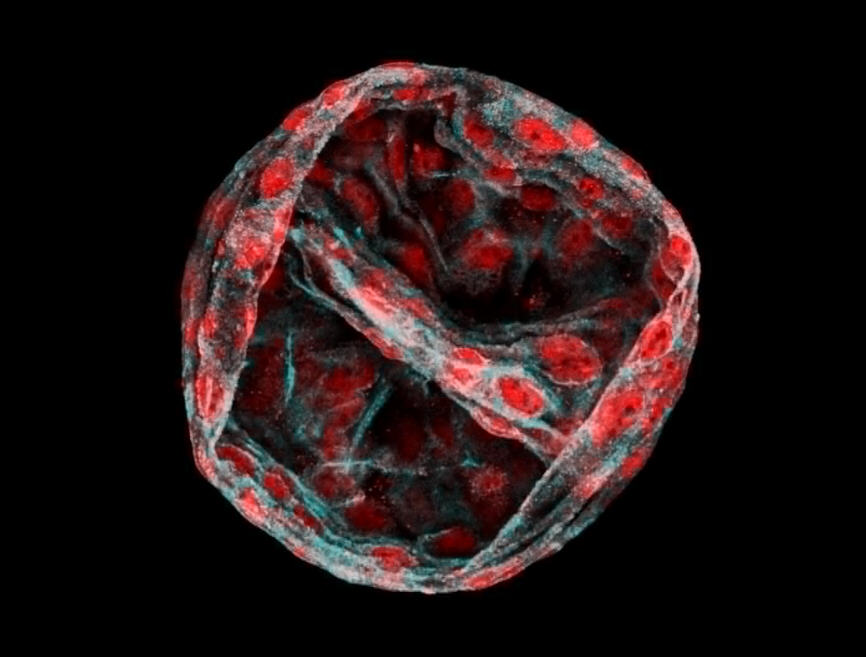博文
代谢酶走向核,为突破性的癌症治疗铺平道路
 精选
精选
||
代谢酶走向核,为突破性的癌症治疗铺平道路
诸平
据西班牙巴塞罗那科技学院基因组调控中心{Centre for Genomic Regulation (CRG), The Barcelona Institute of Science and Technology, Barcelona, Spain}2024年11月12日提供的消息,代谢酶走向核,为突破性的癌症治疗铺平道路(Metabolic Enzymes Go Nuclear, Paving the Way for Breakthrough Cancer Cures)。
通常与能量产生有关的代谢酶(Metabolic enzymes),现在被发现在细胞核中也起着重要作用,比如协调细胞分裂和DNA修复。
基因组调控中心(CRG)的研究揭示了这一突破,强调了酶的双重功能,这可能会带来新的癌症治疗方法,特别是对于像三阴性乳腺癌(triple-negative breast cancer)这样的侵袭性癌症。
CRG的研究人员发现,传统上被认为在能量产生和核苷酸合成中起作用的代谢酶,正在细胞核内执行意想不到的第二项工作。在这个新角色中,这些酶参与了细胞分裂和DNA修复等关键任务。相关研究结果于2024年11月12日已经在《自然通讯》(Nature Communications)杂志网站发表——Natalia Pardo-Lorente, Anestis Gkanogiannis, Luca Cozzuto, Antoni Gañez Zapater, Lorena Espinar, Ritobrata Ghose, Jacqueline Severino, Laura García-López, Rabia Gül Aydin, Laura Martin, Maria Victoria Neguembor, Evangelia Darai, Maria Pia Cosma, Laura Batlle-Morera, Julia Ponomarenko, Sara Sdelci. Nuclear localization of MTHFD2 is required for correct mitosis progression. Nature Communications, 2024, 15, Article number: 9529. DOI: 10.1038/s41467-024-51847-z. Published: 12 November 2024. https://www.nature.com/articles/s41467-024-51847-z
参与此项研究的除了来自西班牙巴塞罗那科技学院基因组调控中心的研究人员之外,还有来自西班牙庞培法布拉大学{Universitat Pompeu Fabra (UPF), Barcelona, Spain}的研究人员。
Lorena Espinar, Marta Garcia-Cao, Alisa Schmidt, Savvas Kourtis, Antoni Gañez Zapater, Carla Aranda-Vallejo, Ritobrata Ghose, Laura Garcia-Lopez, Ilir Sheraj, Natalia Pardo-Lorente, Marina Bantulà, Laura Pascual-Reguant, Evangelia Darai, Maria Guirola, Joan Montero, Sara Sdelci. Nuclear IMPDH2 controls the DNA damage response by modulating PARP1 activity. Nature Communications, 2024, 15, Article number: 9515. DOI: 10.1038/s41467-024-53877-z. Published: 12 November 2024. https://www.nature.com/articles/s41467-024-53877-z
参与此项研究的除了来自西班牙巴塞罗那科技学院基因组调控中心的研究人员之外,还有来自西班牙巴塞罗那大学(Universitat de Barcelona, Barcelona, Spain)和西班牙庞培法布拉大学{Universitat Pompeu Fabra (UPF), Barcelona, Spain}的研究人员。
同一天(11月12日)发表在《自然通讯》(Nature Communications)杂志上的两篇研究论文详细介绍了这些发现,它们不仅挑战了细胞生物学的既定信念,而且为癌症治疗开辟了新的途径,特别是针对侵袭性癌症,如三阴性乳腺癌(triple-negative breast cancer简称TNBC)。
几十年来,生物学教科书对细胞的功能进行了划分:线粒体是细胞的动力源,细胞质是蛋白质合成的中心,细胞核是遗传信息的守卫者。然而,CRG的萨拉·斯德尔奇(Sara Sdelci)博士和她的团队已经证明,这些细胞区室之间的边界比以前所理解的更加流动,代谢酶在它们之间移动,以支持在细胞核中的新功能。
细胞生物学中的酶兼职(Enzymatic Moonlighting in Cellular Biology)
上述两篇研究论文的通讯作者萨拉·斯德尔奇博士说:“代谢酶在它们的传统区域之外有兼职。这就像发现你当地的面包师也是临近城镇的酿酒师一样。他们的技能有重叠之处,但他们从事的是完全不同的工作,目的完全不同。”
“令人惊讶的是,它们在细胞核中的次要作用和它们的主要代谢功能一样重要。这是我们以前没有意识到的一种新的复杂性,”萨拉·斯德尔奇博士补充说。
代谢酶的关键核功能(Critical Nuclear Functions of Metabolic Enzymes)
在其中一项研究中,研究人员纳塔莉亚·帕尔多·洛伦特(Natalia Pardo Lorente)博士专注于代谢酶MTHFD2的研究。传统上,MTHFD2存在于线粒体(mitochondria)中,它在合成生命基石和促进细胞生长方面起着关键作用。纳塔莉亚·帕尔多·洛伦特的研究表明,MTHFD2也在细胞核内兼职,在确保细胞正常分裂方面起着关键作用。
这项研究首次证明,细胞核依赖于代谢途径来维持人类基因组的完整性和稳定性。纳塔莉亚·帕尔多·洛伦特博士解释说:“我们的发现从根本上改变了我们对细胞组织方式的理解,细胞核不仅仅是DNA的被动存储空间,它还有自己的代谢需要和过程。”
应对三阴性乳腺癌(Addressing Triple-Negative Breast Cancer)
在第二项研究中,研究人员Marta García-Cao博士和洛雷娜·埃斯皮纳(Lorena Espinar)博士将他们的注意力转向了三阴性乳腺癌,这是最具侵袭性的乳腺癌类型。大约八分之一的乳腺癌诊断是由这种疾病引起的,全世界每年大约有20万三阴性乳腺癌新病例。
通常,过度的DNA损伤会引发细胞死亡。然而,三阴性乳腺癌(TNBC)有累积DNA损伤而不产生后果的倾向,使其对传统治疗具有弹性。这项研究在一定程度上解释了原因:代谢酶IMPDH2重新定位到TNBC细胞的细胞核,以协助DNA修复过程。Marta García-Cao博士解释说:“IMPDH2就像细胞核中的机械师一样,控制着原本会杀死癌细胞的DNA损伤反应。”
利用癌症代谢弱点进行治疗(Exploiting Cancer’s Metabolic Weaknesses for Therapy)
通过实验操纵IMPDH2水平,研究小组发现他们可以打破平衡。细胞核内增加的IMPDH2使癌细胞的修复机制不堪重负,导致细胞自我毁灭。洛雷娜·埃斯皮纳说:“这就像给一艘正在下沉的船超载更多的水,最终下沉得更快。”他们的方法有效地迫使TNBC细胞屈服于它们通常具有弹性的DNA损伤。
这项研究还可能带来监测癌症的新方法。对IMPDH2的研究还研究了它与PARP1的相互作用,PARP1是一种已经被现有癌症药物靶向的蛋白质。Marta Garcia-Cao解释说:“IMPDH2可以作为生物标志物来预测哪些肿瘤会对PARP1抑制剂产生反应。”
代谢酶的治疗策略和未来(Therapeutic Strategies and the Future of Metabolic Enzymes)
这两项研究都有助于通过利用其代谢脆弱性来治疗癌症的新兴领域。代谢酶是一类全新的治疗靶点。它为对癌细胞的双管齐下的攻击铺平了道路:破坏它们的能量产生,同时削弱它们修复DNA和正常分裂的能力。萨拉·斯德尔奇博士解释说:“将这种策略与传统治疗相结合,可以减少癌症适应的空间,并有助于解决通常的耐药性机制。”
虽然酶在细胞内具有多种作用的概念并不是全新的,但研究表明,这些次要工作的范围和意义才刚刚开始得到重视。纳塔莉亚·帕尔多·洛伦特博士说:“这是一种范式转变,可能还有更多的兼职代谢酶尚未被发现。细胞之间的联系比我们想象的更紧密,这为科学和医学开辟了令人兴奋的可能性。”
本研究得到了西班牙科学与创新部{Spanish Ministry of Science and Innovation through the Centro de Excelencia Severo Ochoa (CEX2020-001049-S, MCIN/AEI /10.13039/501100011033)}、加泰罗尼亚政府(Generalitat de Catalunya through the CERCA programme)、勃林格·殷格翰基金会博士奖学金(Boehringer Ingelheim Fonds Ph.D. fellowship)、欧洲研究理事会{ European Research Council (ERC) under the European Union's Horizon 2020 research and innovation programme (grant agreement No 852343, ERC-StG-852343-EPICAMENTE)}、西班牙计划补助{Spanish Plan Estatal grants (Ministerio de Ciencia e Innovación, PID2019-110598GA-I00/AEI/10.13039/501100011033 and PID2022-141740NB-I00 funded by MICIU /AEI /10.13039/501100011033 / FEDER, UE) and from Fundación BBVA under Beca Leonardo a Investigadores y Creadores Culturales 2022 (LEO22-2-2290-BBM-BAS-167)}以及弗朗西斯科·科博基金会博士后奖学金{Fundación Francisco Cobo (Eduardo Gallego) postdoctoral fellowship}的资助或支持。
上述介绍,仅供参考。欲了解更多信息,敬请注意浏览原文或者相关报道。
Abstract (DOI: 10.1038/s41467-024-51847-z)
Subcellular compartmentalization of metabolic enzymes establishes a unique metabolic environment that elicits specific cellular functions. Indeed, the nuclear translocation of certain metabolic enzymes is required for epigenetic regulation and gene expression control. Here, we show that the nuclear localization of the mitochondrial enzyme methylenetetrahydrofolate dehydrogenase 2 (MTHFD2) ensures mitosis progression. Nuclear MTHFD2 interacts with proteins involved in mitosis regulation and centromere stability, including the methyltransferases KMT5A and DNMT3B. Loss of MTHFD2 induces severe methylation defects and impedes correct mitosis completion. MTHFD2 deficient cells display chromosome congression and segregation defects and accumulate chromosomal aberrations. Blocking the catalytic nuclear function of MTHFD2 recapitulates the phenotype observed in MTHFD2 deficient cells, whereas restricting MTHFD2 to the nucleus is sufficient to ensure correct mitotic progression. Our discovery uncovers a nuclear role for MTHFD2, supporting the notion that translocation of metabolic enzymes to the nucleus is required to meet precise chromatin needs.
Abstract (DOI: 10.1038/s41467-024-53877-z)
Nuclear metabolism and DNA damage response are intertwined processes, but the precise molecular links remain elusive. Here, we explore this crosstalk using triple-negative breast cancer (TNBC) as a model, a subtype often prone to DNA damage accumulation. We show that the de novo purine synthesis enzyme IMPDH2 is enriched on chromatin in TNBC compared to other subtypes. IMPDH2 chromatin localization is DNA damage dependent, and IMPDH2 repression leads to DNA damage accumulation. On chromatin, IMPDH2 interacts with and modulates PARP1 activity by controlling the nuclear availability of NAD+ to fine-tune the DNA damage response. However, when IMPDH2 is restricted to the nucleus, it depletes nuclear NAD+, leading to PARP1 cleavage and cell death. Our study identifies a non-canonical nuclear role for IMPDH2, acting as a convergence point of nuclear metabolism and DNA damage response.
https://blog.sciencenet.cn/blog-212210-1460037.html
上一篇:细胞水平衰老的新视角
下一篇:科学家开发出突破性的鼻喷剂,可将老年痴呆症延缓10年以上
